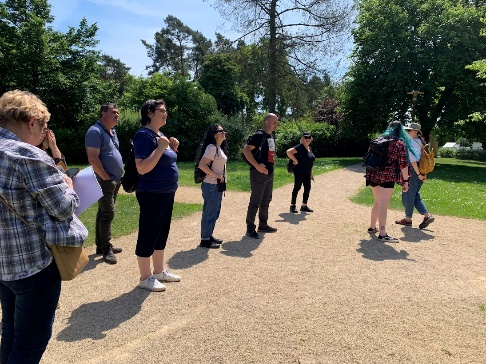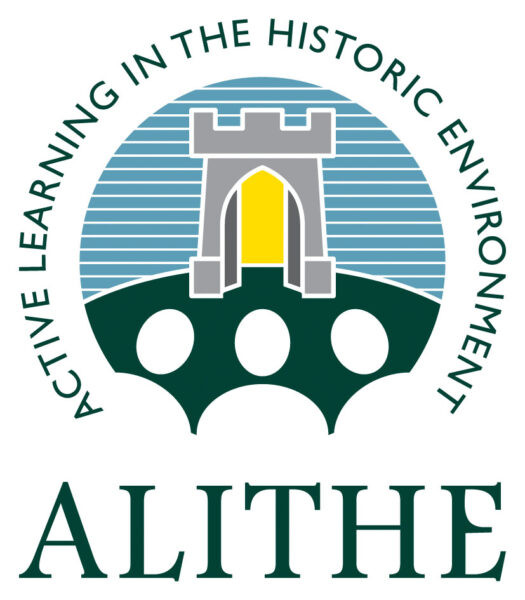
2nd – 9th June 2022, Dubener Heide, Germany
“This project was an amazing opportunity to discovery the culture and traditions of another country (Germany) and to meet new people from all over Europe.” Claudia Maria Mihailescu, participant in ALITHE action in Germany
Introduction:
The organizing body of the workshop ALITHE is an educational institution in the Dübener Heide nature park.It is located in the village of Pressel near the city of Leipzig
Our actions of the ALITHE project takes place in the region of Saxony and Saxony-Anhalt. We get to know institutions and people who are dedicated to traditional craftsmanship to have. We see small businesses, clubs and institutions that preserve old traditions with a lot of arrangement and enthusiasm.
Day 1: We spent the first day in the spa town of Bad Duben. We started with a guided tour of the water mill. We learned about the history of the mill, its operation and the technologies that were advanced for that time. Furthermore, we had the opportunity to find out something about the life of the family that lived and worked in the mill and to see their rooms. The last part of the tour was the rooms that contained crafts workshops such as basketry, shoemaking, herbalism and others.



This was followed by a tour of the city of Bad Duben and a small stop at the tourist information center, where thanks to the tour we learned more about the city and the fauna and flora found there.



2. Day
On the second day, we visited the city of Lutherstadt Wittenberg, in which, thanks to the guide, we also learned lesser-known things about Martin Luther, who is known for being, among other things, a German theologian, university professor and especially the founder of Lutheranism. The guide took us through the city and stopped at important places, connected not only with M. Luther.

3. Day
On the morning of the third day, we visited the city museum in Eilenburg. The exposition consisted of several parts, such as the history of the city, a private collection of toys, memories of the flood in the city, and others. However, the most interesting for us was the replica of the classroom at school, where we had the opportunity to try to write our name using the old script that was used in Germany. The painting on the track, which was discovered in the house of the museum by complete accident, was also dominant. It symbolized the 4 seasons.
In the afternoon we continued to the city of Leipzig, which at that time was hosting two big festivals. One of them was the biggest gothic festival in Europe. We visited the famous monuments of the city, such as the temple where JS Bach also played. We enjoyed the festival atmosphere and ended up having a drink on the roof of the high-rise building that houses the base of the famous German radio station. This building has 30 floors and offers a view of the entire city and its surroundings. It is said that in good sunny weather it is possible to see the Eiffel Tower in the distance.
The fourth day was one of the most interesting for us, because it was in the spirit of the “Mill Tour”, which was actually a circular ride on bicycles, with stops at the mills. This day is associated with festivities in Germany. If I understood correctly, it is Father’s Day and Pentecost together. All the mills in the area were open, there were various workshops and demonstrations of crafts that visitors could try, and there were also markets and food stalls. The whole atmosphere was completed by live music. In total, we visited 3 types of mills and cycled approximately 35 kilometers. We were not stopped even by the rain, which caught us at the last stop at a windmill approximately 5 km from the finish line.



On the fifth day we visited the town of Gräfenhainichen. On this day we visited several interesting places. The first stop was at the pottery, where the owner showed us how to work with clay and how to make different types of ceramics. We had the opportunity to try making our own pottery and then take it home.
After lunch, we visited the museum, which is also located in this city. The exposition was focused primarily on crafts and life in the given period. Each room was focused on something different, for example, a tailor’s room, a shoemaker’s room, a butcher’s shop, a music room, an optician, a dental clinic and others. Each part had a certain story and it was very interesting how they asked us if we knew the objects they were showing us. This supported our concentration and experience of the entire exhibition. The museum was connected with the life of a certain woman who owned a shop and one exposition was dedicated to this shop because, according to the guide, they found all the furniture, equipment and goods from the shop in the attic of the house in which the museum is located.




We also stopped at the place where the metal festival was held, but by that time it was already over, so we didn’t make it to the whole exhibition. The penultimate stop on the day was the exhibition of wooden sculptures, which moves to a different location every two years.
6. Day
On the morning of the sixth day, we visited the swamps in the village of Pressel. We were accommodated in this village for the entire stay. There was a beautiful, untouched nature that provided peace and quiet. Plants that resemble cotton and carnivorous plants grow here. The interesting thing is that the marshes have a low pH and therefore there are no amphibians. A big surprise that we all appreciated was the preparation of a surprise in the form of a small picnic. Under the pretense of “picking up trash,” we made our way to a prepared basket containing homemade punch, beer, and soft drinks.





The last stop of the entire stay was a visit to a blacksmith family and a presentation of artistic blacksmithing. During this tour, we again had the opportunity to try working with a red-hot iron and a heavy hammer.

The European Commission support for the production of this publication does not constitute an endorsement of the contents which reflects the views only of the authors, and the Commission cannot be held responsible for any use which may be made of the information contained therein.

